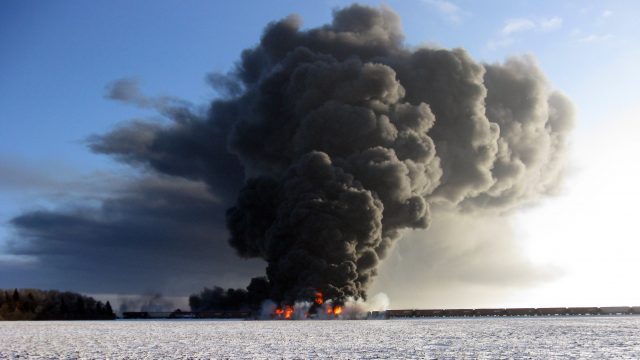Is Oil Industry Getting A Bad Rap For Oil Train Derailments?

Oil train derailments in North Dakota, Canada and Alabama (among other places) has set off a flurry of headlines, and prompted a lot of political activists to suggest that the derailments are proof that we need to slow down oil production.
But what if oil was getting a bad rap, and the recent derailments that have resulted in explosions, spilled oil and death were the result of tanker cars with a lengthy history of well-documented problems which should have been fixed years ago?
…the type of general-service tank car involved in recent incidents with crude oil trains in Quebec, Alabama and North Dakota _ the DOT-111-A _ has a poor safety record with hazardous cargoes that goes back decades, raising questions about why it took so long for the railroad industry and its federal regulators to address a problem they knew how to fix.
Other, more specialized types of tank cars received safety upgrades in the 1980s, and the industry’s own research shows they were effective at reducing the severity of accidents.
Tank car manufacturers have built new DOT-111A cars to a higher standard since 2011, but the improvements haven’t caught up to tens of thousands of older cars.
The problems with the DOT-111A cars goes back decades with no fixes despite the NTSB pointing out problems with the rail cars again and again:
By the early 1980s, pressurized cars were equipped with puncture-resistant shields, fire-resistant thermal insulation and devices to help the cars stay coupled in derailments, reducing the risk that they could strike and puncture each other.
The non-pressurized DOT-111A, however, was left mostly unaltered. …
In accident after accident over the next three decades, the NTSB repeatedly referred to the cars’ shortcomings.
“The inadequacy of the protection provided by DOT-111A tank cars for certain dangerous products has been evident for many years,” the NTSB wrote the Federal Railroad Administration in a letter dated July 1, 1991.
There is no doubt that there has been a sharp increase in the amount of oil-by-rail traffic in the United States, with roughly 50% of that traffic originating in North Dakota. Even so, railroads have a nearly perfect delivery record, with over 99% of trains carrying hazardous materials (including oil) reaching their destinations safely. That may be about as close to perfect as any human endeavor could hope to achieve.
But it isn’t perfect. Wrecks and derailments happen, and even with a success rate over 99% they happen more frequently as you put more trains on the tracks. That, I think, is inevitable. The problem isn’t so much the derailments, I think, but what happens after the derailment.
The preliminary NTSB report released for the derailment near Casselton, North Dakota, implicated the rail cars (which were of the DOT-111A variety). Were the oil on that train being transported with an updated rail car with more safety features, would we even be talking about the Casselton derailment?
Maybe not. That’s something to keep in mind as some use train derailments to argue against oil production.




